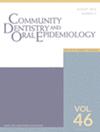Does subsidizing the cost of care impact on dental attendance patterns among older adults?
Abstract
Objectives
To assess whether eligibility for an age-related universal (pioneer generation [PG]) subsidy incentivises dental attendance by older Singaporeans.
Methods
Data were collected between 2018 and 2021 from in-person interviews of Singaporean adults aged 60–90 years using a questionnaire and a clinical examination. The questionnaire included details of age, gender, ethnicity, education, residential status, socio-economic status, marital status, eligibility for subsidy (community health assistance/CHAS, PG or both) and frequency of dental attendance. The clinical examination recorded number of teeth (categorized as edentulous, 1–9 teeth;10–19 teeth; ≥20 teeth). To estimate the effect of the PG subsidy on dental attendance pattern, a regression discontinuity (RD) analysis was applied using age as the assignment variable.
Results
A total of 1172 participants aged 60–90 years (64.2% female) were recruited, with 498 (43%) being eligible for the PG subsidy. For those eligible for PG subsidy, there was a higher proportion of regular attenders than irregular attenders (53.6% vs. 46.4%). In age adjusted RD analysis, those eligible for the PG subsidy were 1.6 (95% CI: 1.0, 2.7) times more likely to report regular attendance than their PG non-eligible counterparts. The association remained strong (OR 2.1; 95% CI: 1.1–3.7) even after further controlling for demographics, socioeconomic factors, number of teeth and eligibility for the CHAS subsidy.
Conclusions
Being eligible for the PG subsidy substantially increased the odds of regular dental attendance.


 求助内容:
求助内容: 应助结果提醒方式:
应助结果提醒方式:


